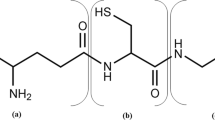Abstract
Recently, the interest in mimicking functions of chalcogen-based catalytic antioxidants like selenoenzymes, has been increased. Various attempts had been done with selenium, but very few attempts were carried out with tellurium. Bio-complex formation and characterization of tellurium was not tried earlier by using any organism. The present study was focused on tellurium peptide production, characterization, and bioactivity assessment especially Mimetic to glutathione peroxidase (GPx). The production was achieved by the autolysis of total proteins obtained from Saccharomyces cerevisiae ATCC 7752 grown with inorganic tellurium. The GPx-like activity of the hydrolyzed tellurium peptide was increased when prepared by autolysis, but decreased when prepared by acid hydrolysis. Tellurium peptide produced by autolysis of the yeast cell showed increased GPx-like activity as well as tellurium content. Tellurium peptide showed little toxicity, compared to highly toxic inorganic tellurium. The results showed the potential of tellurium peptide as an antioxidant that can be produced by simple autolysis of yeast cells.







Similar content being viewed by others
References
Ba, L. A., Döring, M., Jamier, V., & Jacob, C. (2010). Tellurium: an element with great biological potency and potential. Organic and Biomolecular Chemistry, 8(19), 4203–4216.
Cunha, R. L., Gouvea, I. E., & Juliano, L. (2009). A glimpse on biological activities of tellurium compounds. Anais da Academia Brasileira de Ciências, 81(3), 393–407.
Asakura, T., Shibutani, Y., Reilly, M. P., & deMeio, R. H. (1984). Antisickling effect of tellurite: a potent membrane acting agent in vitro. Blood, 64, 305–307.
Jacobs, J. L. (1989). Immunologic developments in AIDS. The Year in Immunology, 4, 276–285.
Shohat, M., Mimouni, D., Ben-Amitai, D., Sredni, B., Sredni, D., Shohat, B., et al. (2005). In vitro cytokine profile in childhood alopecia areata and the immunomodulatory effects of AS-101. Clinical and Experimental Dermatology, 30, 432–434.
Guest, I., & Uertrecht, J. (2001). Bone marrow stem cell protection from chemotherapy by low molecular weight compounds. Experimental Hematology, 29, 123–137.
Rooseboom, M., Vermeulen, N. P., Durgut, F., & Commandeur, J. N. (2002). Comparative study on the bioactivation mechanisms and cytotoxicity of Te-phenyl-L-tellurocysteine, Se-phenyl-L-selenocysteine, and S-phenyl-L-cysteine. Chemical Research in Toxicology, 15(12), 1610–1618.
Kanski, J., Drake, J., Aksenova, M., Engman, L., & Butterfield, D. A. (2001). Antioxidant activity of the organotellurium compound 3-[4-(N, N- dimethylamino) benzenetellurenyl] propanesulfonic acid against oxidative stress in synaptosomal membrane systems and neuronal cultures. Brain Research, 911(1), 12–21.
Sies, H., & Arteel, G. E. (2000). Interaction of peroxynitrite with selenoproteins and glutathione peroxidase mimics. Free Radical Biology and Medicine, 28, 1451–1455.
Moroder, L. (2005). Isosteric replacement of sulfur with other chalcogens in peptides and proteins. Journal of Peptide Science, 11(4), 187–214.
Andersson, C. M., Hallberg, A., Brattsand, R., Cotgreave, I. A., Engman, L., & Persson, J. (1993). Glutathione peroxidase-like activity of diaryl tellurides. Bioorg. Medicinal Chemistry Letters, 3, 2553–2558.
Wieslander, E., Engman, L., Svensjo, E., Erlansson, M., Johansson, U., Linden, M., et al. (1998). Antioxidative properties of organotellurium compounds in cell systems. Biochemical Pharmacology, 55, 573–584.
Lee, J. O., Kim, Y. O., Shin, D. H., Shin, J. H., & Kim, E. K. (2006). Production of selenium peptide by autolysis of Saccharomyces cerevisiae. Journal of Microbiology and Biotechnology, 16(7), 1047–1052.
Mao, S., Dong, Z., Liu, J., Li, X., Liu, X., Luo, G., et al. (2005). Semisynthetic tellurosubtilisin with glutathione peroxidase activity. Journal of the American Chemical Society, 127(33), 11588–11589.
Paglia, D. E., & Valentine, W. N. (1967). Studies on the quantitative and qualitative characterization of erythrocyte glutathione peroxidase. Journal of Laboratory and Clinical Medicine, 70, 158–169.
Bauer, C., Herzog, V., & Bauer, M. F. (2001). Improved technique for electron microscope visualization of yeast membrane structure. Microscopy and Microanalysis, 7(6), 530–534.
Cho, K. H., & Suh, J. K. (1999). Determination of arsenic, lead, and selenium in rice flour by graphite furnace atomic absorption spectrometry. Analytical Science and Technology, 12, 130–135.
Hernandez-Caraballo, E. A., Burguera, M., & Burguera, J. L. (2002). Evaluation of ammonia as diluent for serum sample preparation and determination of selenium by graphite furnace atomic absorption spectrometry. Spectrochim. Acta Part B. Atomic Spectroscopy, 57, 2159–2165.
Boonraeng, S., Foo-Trakul, P., Kanlayakrit, W., Chetanachitra, C., & Kasetsart, J. (2000). Effects of chemical, biochemical and physical treatments on the kinetics and on the role of some endogenous enzymes action of Baker’s yeast lysis for food- grade yeast extract production. Natural Science, 34, 270–278.
Siripornadulsil, S., Traina, S., Verma, D. P., & Sayre, R. T. (2002). Molecular mechanisms of proline-mediated tolerance to toxic heavy metals in transgenic microalgae. Plant Cell, 14(11), 2837–2847.
Acknowledgments
This study was supported by a grant of the Korea Healthcare technology R&D Project, Ministry of Health & Welfare, Republic of Korea (Grant No.: A103017). The authors also acknowledge the Inha University, Korea for providing the required assets and environment.
Author information
Authors and Affiliations
Corresponding authors
Rights and permissions
About this article
Cite this article
Morya, V.K., Dong, S.J. & Kim, Ek. Production and Characterization Te-Peptide by Induced Autolysis of Saccharomyces Cerevisiae . Appl Biochem Biotechnol 172, 3390–3401 (2014). https://doi.org/10.1007/s12010-014-0780-y
Received:
Accepted:
Published:
Issue Date:
DOI: https://doi.org/10.1007/s12010-014-0780-y




